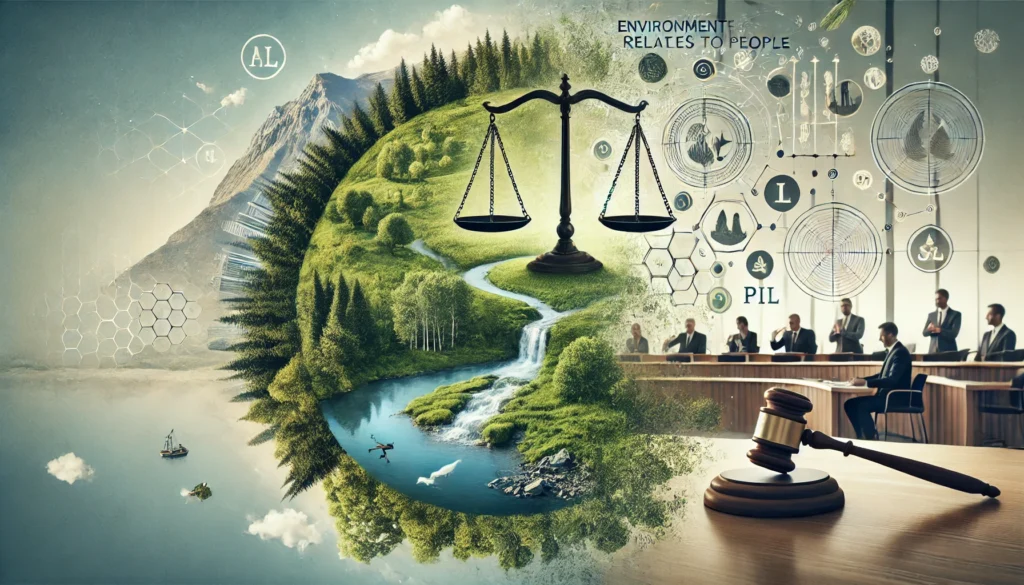Published On: 22nd July, 2024
Authored By: Samriddhi Tiwari
Atal Bihari Vajpayee School of Legal Studies, CSJM University
ABSTRACT:
This article inspects the landmark judgment delivered by the Supreme Court in the M.K Ranjitsinh vs Union of India case which recognized the right to be free from adverse climate change as a fundamental right. The research work also focuses on the affiliation of recent judgment with the right to equality (Article 14) and life (Article 21) enshrined in the Indian constitution. The study devotes a considerable portion to the causes and fatal impacts of global warming throughout the world and how it is destroying the natural habitat and ecosystem of the globe by rendering it precarious for the present as well as future generations. The research addresses the controversial debate between environmental welfare and human interests. It further explores the details of various climate litigations around the world and discovers the intricacies of India’s international obligations towards the environment and greenhouse gas emissions. The analysis not only highlights the importance of the aforementioned judgement but also mentions important steps to be taken to save Mother Earth from the deadly clutches of climatic change.
KEYWORDS: Supreme court judgment, adverse climatic change, Right to equality, Right to life, environmental welfare, Climate litigation, and International obligations.
INTRODUCTION:
Homo Sapiens are considered the most evolved creation of nature. Their inquisitive and ambitious bearing has led to copious creations and one of the most vital among them is Industrialisation.
Discovered in the 19th century, Industrialisation has indeed led to steadfast human growth however as every coin has two sides, the negative faction of industrialization cannot be ignored. One such bleak result of mechanization is climate change.
MEANING AND CAUSES :
According to the United Nations, climate change refers to long-term shifts in temperature and weather patterns[1]. These shifts are mainly the result of the activities of the sun or volcanic eruptions however in recent years these shifts have been directly caused due to the man-made activities of burning fossil fuels, deforestation farming livestock, and many more.
Climate change and global warming are directly enmeshed with the emission of greenhouse gases like carbon dioxide, methane, ozone, nitrous oxide, chlorofluorocarbon, and water vapor. These greenhouse gases trap the heat of the sun which induces climate change.
IMPACT ON THE WORLD:
Recently 550 hajj pilgrims were reported dead amid lethal heatwave in Mecca[2]. The rising temperature all around the world has become a cause of concern for humanity. Yet, the most prominent fact is that climate change is not only limited to soaring temperatures but is also a component behind changes in weather patterns, rise in water levels, drought, and flooding. Climate change has adversely affected a plethora of sectors ranging from production to human health. It has not only detorted the food chain of the ecosystem but has disdainfully impacted the condition of flora and fauna across the globe.
The National Oceanic And Atmospheric Administration (NOAA) has reported several changes in global climate[3]:-
1. Global temperature rose from 1.8 degrees Fahrenheit from 1901 to 2020. 2.Sea level rise has accelerated to 8.2 mm/year.
3. Approximately 30 glaciers have reduced to 60 feet since 1980.
SITUATION IN INDIA:
India also known as Bharat has always worshipped Earth as mother goddess. Like many eastern countries, India also has a rich history of pagan religions where various aspects of nature are worshipped.
However, the 21st century has seen a dynamic shift in the perspective of Indians towards natural heritage.
According to UNICEF, India’s average temperature has risen by around 0.7 degrees Celsius from 1901 -to 2018[4] India was the 7th most affected country due climate led extreme weather events -both in terms of the fatalities (2,267) people as well as economic losses (66,182 million)[5]
Hence, the historic judgment of the Supreme Court in Ranjitsinh vs Union of India (6) has come across as a silver lining amidst these vicious climatic trends.
M.K RANJITSINH VS UNION OF INDIA
On 21st March 2024, the Supreme Court of India delivered a landmark judgment in the case of Ranjitsinh vs Union of India. The court’s order granting protection against adverse climate change and bringing it under the purview of fundamental rights has paved the path for a progressive battle against India’s degrading climatic conditions. The judgment has successfully indicated the need for equilibrium between sustainable development and the protection of endangered species.
BACKGROUND:
In 2019, a writ petition was brought to the Supreme Court by Ranjitsinh Jhala, former chairman of the Wildlife Trust of India for the protection and conservation of Great Indian Bustard (GIB) and Lesser Florian against overhead transmission lines[6]. The Great Indian Bustard also known as Ardeotis.
Nigriceps are commonly found in the states of Rajasthan and Gujarat. This large bird which is known to have a place among the heaviest flying birds used to be a common sight in India.
Shrublands however in the last decades this bird has faced a major existential crisis and one of the major reasons behind their dwindling numbers has been overhead transmission lines. The GIB has relatively poor vision and large size which leads to their collision with transmission lines.
In 2021, an inceptive judgment was given by the honorable court in the aforementioned matter.
The court not only restricted the installation of overhead transmission lines in an area of 99000 sq. km but also directed that any transmission lines that were laid down for electrification projects should be placed underground. However, the judgment of 2021 was met with resistance from solar power and wind energy companies. It must be noted that the Ministry of New and Renewable Energy (MNRE) also showed disagreements towards the court’s order stating that the implementation would have unpropitious effects on India’s commitment towards the Paris Agreement signed by the nation under the United Nations Framework Convention on Climate Change (UNFCC).[7]
Hence, the court decided to review its 2021 verdict and replace it with a much more pertinent decision that could cater to the needs of development and also ensure environmental progress.
DETAILED INSIGHT OF CURRENT JUDGEMENT
The Supreme Court of India has delivered its judgment based on below mentioned considerations which will be studied by us in this article:
1. India’s commitment to international conventions: In its historic verdict, the Supreme Court
conceded India’s commitment to the international conventions to effectively aid its battle against climate change and global warming. It is notable to state that India has committed to achieve approximately 50% cumulative electric power installed capacity from non-fossil fuel-based energy resources by 2030[8]. We cannot ignore the fact that renewable energy is the future of the upcoming generation as non-renewable sources of energy are not accessible to everyone and their depletion is inevitable.
Apart from this, India has ratified several international conventions and protocols for creating a safe environment in the world.
- UNFCC( UNITED NATIONS FRAMEWORK CONVENTION ON CLIMATE CHANGE): Signed in 1992 at the Rio Conference popularly known as the Earth Summit, UNFCC is a parent treaty of the 1997 Kyoto Protocol and the 2015 Paris Agreement. The objective of the UNFCC is to achieve sustainable development through the stabilization of greenhouse gas concentration in the atmosphere[9]. India has been a signatory to UNFCC since June 10, 1992.
- KYOTO PROTOCOL: Adopted in Japan in 1997, the agreement played a fundamental role in recognizing the vast role of developed countries in the emission of greenhouse The protocol is known for giving a target to these industrialized countries of reducing their emission by least 18%.India signed the protocol in 2002.
- PARIS AGREEMENT: Also known as Conference of Parties 21 or COP 21, this landmark accord replaced the previous Kyoto Protocol and was adopted in 2015 to mitigate the negative impingement of climate change across the globe. One of its goals is to limit the temperature to 1.5 degrees Celsius by 2100. The agreement also serves the needs of underdeveloped countries that are profusely affected by the hazardous effects of global warming both financially and health-wise. India has reaffirmed its INDC(Intended
Nationally Determined Contribution) commitment to meet the goals under the above agreement.
It must be noted that Article 51-c of the Indian constitution also states that India must “foster respect for International law and treaty obligations in the dealing of organized people with one another[10].
2. The right to a healthy environment and the right to be free from adverse climate change as a fundamental right: The Supreme Court stated that the right to be free from adverse effects of climate change is a fundamental right granted to every citizen under the ambit of right to life (21) and right to equality (14) enshrined in the Indian constitution.
- RIGHT TO LIFE (ARTICLE 21): Article 21 of the Indian constitution states that “No person shall be deprived of his life or personal liberty except according to procedure established by law”.Yet, the negative notions of climate change have been detrimental in Depriving people of their healthy lives and hence violating Article 21 in word and spirit. The persistent increase in the emission of greenhouse gases has led to life-threatening diseases like respiratory and health-related problems such as Lyme disease and West Nile virus. Apart from that SC also took notice of its precedent taken in M.C Mehta vs Kamalnath[11] and stated that the right to a clean healthy and safe ecosystem comes within the ambit of Article 21
- RIGHT TO EQUALITY (ARTICLE 14): Article 14 of the Indian constitution states that “State shall not deny equality before law and equal protection of law within the territory of India”[12]The concept of equal protection of law implies equal treatment in equal circumstances however the effects of global warming and climate change are most menacing for downtrodden and poor than affluent and rich. Therefore, it clearly leaves impecunious people in the lurch when they are facing the deadliest side of climate emergency and have little to no resources for protecting themselves. Thence, it becomes the duty of law to ensure that equal protection is granted to these people against these adverse effects.
3. Solar energy as a source of renewable energy: We all know that non-renewable resources like fossil fuels are meant to deplete after a period of time hence it is the need hour that we turn our attention towards renewable sources of energy and one such source is solar energy which is sustainable, non-depletable and inexhaustible. The Supreme Court has focused on increasing the use of solar energy for sustainable growth and development. It can be used for charging batteries, solar heating, hot air solar systems, and solar cells.
4. Climate change litigation in other jurisdictions: It is to be stated that the Supreme Court took inspiration from climate change litigation around the world to form a verdict that is going to shape the future of India’s forthcoming approach towards climate change according to Global Climate litigation report, “There have been 2,180 climate-related cases filed in 65 jurisdictions, including international and regional courts, tribunals, quasi-judicial bodies, or other adjudicatory bodies, such as Special Procedures at the United Nations and arbitration tribunals as of December 2022. This represents a steady increase from 884 cases in 2017 and 1,550 cases in 2020.”[13]It is vital to include that recently the Grand Chamber of the European Court of Human Rights delivered a judgment stating the government of Switzerland has been guilty of violating Articles 1,6and 8 of the European Convention on Human Rights [14][15][16] as the country did not take sufficient steps against the dangerous and life-threatening effects of climate change. The government of Switzerland was also found guilty of not providing a healthy and safe environment to its citizens which is a basic requirement.[17]Therefore, it is safe to state that the Supreme Court’s decision has been positively influenced by the climate litigations across the globe and shows the inclination of India’s judicial system to walk hand in hand with the progressing world.
5. Dilemma between conservation of biodiversity and sustainable development: The court agreed that there was a dilemma between conservation of nature and sustainable growth. The transmission lines which are important for the distribution of solar energy cannot be installed underground as it is not a technically suitable step and is not going to solely help in the conservation of GIB. The Supreme Court has directed the formation of a committee to assess the feasibility of undergrounding power lines, the efficacy of bird diverters, and identify the number of bird diverters required for the successful implementation of conservation efforts.[18]
EFFORTS TAKEN BY INDIA
- National Action Plan On Climate Change (NAPCC): As suggested by its name this action plan focuses on mitigating the harmful effects of climatic change and building a better ecosystem for the present and future. It focuses on 8 core missions Solar Energy; Enhanced Energy Efficiency; Sustainable Habitat; Water; Sustaining the Himalayan Ecosystem; Green India; and Sustainability. Agriculture; and Strategic Knowledge for Climate Change.[19]
- National Clean Energy Fund: Started in 2010, the fund was established to aid the financial requirement for carrying out research and development in the fields of pollution, climate change, and global warming.
- Paris Agreement: India has been a signatory to the Paris Agreement which has been a powerful force behind the protection of underdeveloped and developing countries against precarious impacts of climatic change all around the world. It has been a fundamental accord to provide financial assistance to all those countries who have suffered the cost of selfishness shown by developed countries using nonrenewable sources of energy for their ambitions and power-hungry motives.
IMPORTANCE OF THE JUDGEMENT
Prior to this judgement, the protection of the environment was only seen as a directive principle of state policy under articles 48 A and 51 A(g) which was not legally binding. However, the recent judgment has totally changed the approach by bringing the right to a healthy environment under the ambit of fundamental rights. This has ensured that any action taken against the future of a sustainable ecosystem can be legally challenged and as it would be violative of fundamental rights hence, it would strengthen any litigation on this matter.
The laws regarding the protection of the environment have always been fragmented however the judgement provides a holistic outlook to the issue and deals with the problem of climate change in a more comprehensive manner. It does not focus on a single environmental concern but rather covers all the necessary avenues of climatic problems and relates them to human life and equality.
Lastly, the judgment strengthens the position of the Indian judiciary by showing its progressive approach to such sensitive matters. It also communicates India’s commitment to world development and growth.
CONCLUSIONS
It is essential to understand that the step taken by the Indian Judiciary is indeed going to serve as a landmark for future litigations at the domestic level as it provides clarity towards the problem of climate change and shows the court’s responsible and sensitive approach towards its causes, impacts, and mitigation. The verdict is fundamental in answering the question of approaching the environmental concern from a humanitarian perspective rather than a developmental view.
The judgment also shows India’s unwavering support and commitment to its international obligations and outlines the progressive, optimistic, and scientific mindset of the honorable court.
However, it should not be ignored that the nature of environmental laws in India is very disorganized and fragmental. They are lenient when compared to the environmental laws in Germany, the Netherlands, and Finland.
The major concern for India is that problems like climate change and global warming are still not considered important enough to be discussed at the household level. As India continues to fight its battle against basic issues of sanitation and health, these ecosystem-based concerns are mostly overlooked.
It is the need of the hour that we Indians understand the hazardous impacts of climatic change and start taking necessary steps for its mitigation. The Indian government must ensure that stringent laws are made for these issues so that India can become an example for countries around the world and achieve its ambition of becoming the ‘Vishwa guru’ in the true sense of the word.
Reference(s):
[1] CLIMATE ACTION,https://www.un.org/en/climatechange/science/causes-effects-climate-change(June 23,2024)
[2] INDIA TODAY,https://www.indiatoday.in/world/video/hajj-pilgrims-death-heat-2555184-2024-06-19(June 23,2024)
[3] NOAA,https://www.noaa.gov/education/resource-collections/climate/climate-change-impacts(June 23,2024)
[4] Climate change in India, BYJUS,https://byjus.com/free-ias-prep/climate-change-in-india-upsc-notes/(June 23, 2024)
[5] id.
[6] Paul kumar&Abhayraj Naik, India’s New Constitutional Climate Right, VERFASSUNGSBLOG,https://verfassungsblog.de/indias-new-constitutional-climate-right/(June 24th,2024)
[7] CLIMATECASECHART.COM,https://climatecasechart.com/non-us-case/mk-ranjitsinh-ors-v-union-of-india-ors/(June 24,2024)
[8] DRISTI IAS,https://www.drishtiias.com/to-the-points/paper3/environmental-conventions-climate-change(June 24,2024)
[9] id.
[10] INDIA CONST.art 51 -c
[11] M.C Mehta vs Kamalnath (1997)1SCC 388
[12] INDIA CONST.art 14
[13] GLOBAL CLIMATE LITIGATION REPORT
2023,https://www.unep.org/resources/report/global-climate-litigation-report-2023-status-review(June 24,2024)
[14] “The High Contracting Parties shall secure to everyone within their jurisdiction the rights and freedoms defined in Section I of this Convention”.
[15] “Right to a fair and public hearing”.
[16] .”Everyone has the right to respect for his private and family life, his home, and his correspondence.”
[17] UNITED NATIONS ENVIRONMENT PROGRAMME,
https://www.unep.org/news-and-stories/story/why-string-court-victories-raising-hopes-climate-advocates(June 26, 2024)
[18] BAR&BENCH,https://www.barandbench.com/columns/mk-ranjitsinh-v-union-of-india-the-supreme-courts-very-own-sophies-choice-moment
(June 26, 2024)
[19] BYJUS,https://byjus.com/free-ias-prep/climate-change-in-india-upsc-notes/(June 26,2024)




